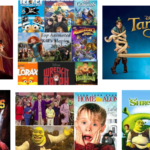Bollywood, the vibrant and dynamic Hindi-language film industry based in Mumbai (formerly Bombay), is a significant cultural phenomenon both in India and around the world. With its unique blend of music, dance, drama, and romance, Bollywood films have captivated audiences globally. This exploration delves into Bollywood’s history, characteristics, key figures, and its profound impact on global culture.
1. A Brief History of Bollywood
Early Beginnings (1910s-1930s)
- First Films: The first silent film, Raja Harishchandra, was released in 1913 by Dadasaheb Phalke, often regarded as the father of Indian cinema.
- Talkies Era: The introduction of sound in the late 1920s, with films like Alam Ara (1931), marked the transition to “talkies,” paving the way for musical storytelling.
The Golden Age (1950s-1960s)
- Cinematic Innovations: This era witnessed the emergence of legendary filmmakers such as Satyajit Ray, who brought international acclaim to Indian cinema with films like Pather Panchali.
- Bollywood Defined: The term “Bollywood” began to gain traction during this period, as commercial Hindi cinema took shape, focusing on themes of love, family, and social issues.
The 1970s-1980s: Masala Films
- Emergence of Masala: The 1970s saw the rise of the “masala” genre, combining elements of action, comedy, romance, and melodrama. Films like Sholay became iconic.
- Influential Stars: This period introduced actors like Amitabh Bachchan, whose larger-than-life persona revolutionized the industry.
Modern Era (1990s-Present)
- Globalization of Bollywood: The 1990s marked Bollywood’s entry into the global market, with films like Dilwale Dulhania Le Jayenge capturing international audiences.
- Digital Revolution: The rise of digital platforms and social media has transformed distribution and marketing, making Bollywood accessible worldwide.
2. Key Characteristics of Bollywood Films
Musical Elements
- Song and Dance: Bollywood films are renowned for their elaborate musical numbers, often integral to the storyline. Each film typically features several songs that enhance the narrative.
- Cultural Diversity: The music blends traditional Indian styles (like classical and folk) with contemporary genres (like pop and hip-hop).
Dramatic Storytelling
- Emotional Themes: Common themes include love, sacrifice, family values, and social justice, often interwoven with melodrama and humor.
- Colorful Visuals: Lavish sets, vibrant costumes, and dynamic choreography are hallmarks of Bollywood cinema, creating an immersive visual experience.
Star Power
- Iconic Actors and Actresses: The film industry has produced legendary figures such as Raj Kapoor, Madhuri Dixit, Shah Rukh Khan, and Deepika Padukone, whose fan followings extend beyond India.
- Influence on Culture: Bollywood stars often shape fashion trends, social issues, and cultural dialogues, becoming symbols of contemporary Indian society.
3. Key Figures in Bollywood
Directors
- Raj Kapoor: A pioneering filmmaker and actor, known for films that explored social themes.
- Yash Chopra: Credited with creating romantic films that became cultural milestones, like Dil To Pagal Hai.
- Karan Johar: A contemporary filmmaker who has blended traditional narratives with modern sensibilities.
Actors
- Shah Rukh Khan: Dubbed the “King of Bollywood,” he has achieved immense fame and contributed to the global appeal of Hindi cinema.
- Amitabh Bachchan: Known for his powerful performances and versatility, he has played a crucial role in popularizing Indian cinema globally.
- Priyanka Chopra: An actress who has successfully transitioned to Hollywood, bridging the gap between Indian and international cinema.
Music Composers
- A.R. Rahman: An Oscar-winning composer whose work has brought Indian music to global audiences, blending traditional and modern sounds.
- Lata Mangeshkar: An iconic playback singer whose voice has defined Bollywood music for decades.
4. Bollywood’s Global Impact
Cultural Influence
- Diaspora Connection: Bollywood films resonate with the Indian diaspora, serving as a link to cultural roots and traditions.
- Cultural Exchange: The global popularity of Bollywood has led to collaborations with international artists, creating a fusion of styles and genres.
Economic Impact
- Box Office Success: Bollywood is a multi-billion-dollar industry, contributing significantly to India’s economy and creating millions of jobs.
- International Film Festivals: Indian films are increasingly recognized at international film festivals, garnering accolades and showcasing talent.
Digital Platforms and Accessibility
- Streaming Services: Platforms like Netflix and Amazon Prime Video have embraced Bollywood, making films accessible to a global audience and increasing viewership.
- Social Media: Actors and filmmakers use social media to connect with fans worldwide, further promoting Indian cinema.
5. Challenges and Future Prospects
Challenges
- Content Quality: With rapid production rates, the quality of films can vary significantly, leading to criticism.
- Censorship Issues: Navigating societal norms and censorship regulations can pose challenges for filmmakers tackling sensitive topics.
Future Prospects
- Innovation in Storytelling: New filmmakers are pushing boundaries, exploring diverse narratives that resonate with younger audiences.
- Technological Advancements: Embracing cutting-edge technology in filmmaking and distribution will enhance production quality and reach.
Conclusion
Bollywood stands as a testament to India’s rich cultural heritage and its ability to evolve while maintaining its unique identity. The industry’s influence extends far beyond entertainment; it serves as a medium for cultural exchange, a catalyst for social change, and a source of inspiration for millions worldwide. As Bollywood continues to grow and adapt, its global impact is sure to deepen, weaving Indian stories into the fabric of world cinema.
Introduction to Bollywood
Bollywood, a term that derives from the combination of Bombay (now Mumbai) and Hollywood, represents India’s vibrant film industry. Originating in the early 20th century, Bollywood has evolved from its initial silent films to intricate sound films filled with music and dance, thereby embodying a cultural ethos that resonates with diverse audiences. The genesis of this film industry can be traced back to the 1913 release of “Raja Harishchandra,” directed by Dadasaheb Phalke, which is considered India’s first feature film. This milestone marked the beginning of an illustrious journey filled with creativity and innovation.
Culturally, Bollywood serves as a reflection of Indian society, seamlessly weaving together elements of tradition, social issues, and modernity. Its narratives often include themes of love, family, and morality, which resonate deeply with viewers. Over the decades, Bollywood has transformed significantly, adapting to changes in societal norms and audience preferences while retaining its unique identifiers, such as song and dance sequences that are integral to its storytelling. Unlike Hollywood, Bollywood films often incorporate elaborate melodies and choreography, creating a distinctive viewing experience that captivates its audience.
The geographical context of Bollywood is rooted in Mumbai, which serves as the heart of the Indian film industry. This urban hub not only fosters artistic expression but also attracts talent from across the nation, resulting in a melting pot of cultures and ideas. Furthermore, Bollywood has grown beyond its local context, achieving a presence in the global film arena. Its reach has expanded significantly, gaining international recognition and influencing cinema worldwide. Today, Bollywood films are celebrated not just for their entertainment value but also for their ability to connect with audiences on multiple levels, contributing to a greater understanding of Indian culture globally.
The Evolution of Bollywood: From Black and White to Color
Bollywood, as India’s preeminent film industry, has experienced incredible evolution since its inception over a century ago. In the early days, the industry produced silent films, with 1913 marking a significant milestone through the release of “Raja Harishchandra,” directed by Dadasaheb Phalke. This film not only showcased the artistic potential of Indian cinema but also laid the foundation for storytelling in Bollywood.
The transition from silent films to talkies in 1931 heralded a new era for Bollywood. The advent of sound revolutionized filmmaking and allowed for the incorporation of vocal performances, music, and dialogue, making films more engaging for audiences. The first Indian talkie, “Alam Ara,” captivated viewers with its songs and performances, setting a standard that would shape future productions. This period also saw the emergence of musical dramas, a genre that became synonymous with Bollywood.
As technology advanced, the introduction of color films in the 1950s marked another pivotal moment in Bollywood’s history. The film “Kagaz Ke Phool,” released in 1959, showcased the artistic possibilities of color, further enriching the visual experience of cinema. This transition not only influenced the aesthetics of the films but also enabled filmmakers to explore vibrant narratives and culturally significant themes more profoundly.
Throughout the decades, Bollywood’s evolution has continually mirrored the societal changes and cultural shifts within India. The industry began to embrace more diverse storylines, reflecting the struggles and aspirations of contemporary society. Moreover, advances in filmmaking techniques, such as the use of CGI and sophisticated editing systems, have further propelled Bollywood onto the world stage, allowing it to create films that resonate globally while retaining an essence of Indian culture.
Key Figures in Bollywood: Actors, Directors, and Producers
Bollywood, as one of the largest film industries in the world, has been significantly shaped by its key figures. Iconic actors have long captivated audiences with their remarkable performances, charismatic presence, and transformative roles. One of the most influential actors in Bollywood history is Amitabh Bachchan, often referred to as the “Shahenshah of Bollywood.” His diverse filmography and powerful acting have not only garnered him numerous awards but also established him as a global ambassador for Indian cinema.
Another monumental figure is Shah Rukh Khan, commonly known as the “King of Bollywood.” Khan’s ability to convey deep emotions and his charm have gained him a vast international fanbase, paving the way for Bollywood’s global appeal. Similarly, actress Deepika Padukone has emerged as a vital figure, breaking barriers and earning acclaim both in India and abroad. Her performances in films like “Padmaavat” and her work in international projects such as “xXx: Return of Xander Cage” showcase Bollywood’s expanding reach.
Equally important are the visionary directors who shape the narratives and aesthetics of Bollywood films. Directors such as Rajkumar Hirani and Sanjay Leela Bhansali have introduced innovative storytelling techniques and grand visual spectacles that have enriched the industry. Their films often explore themes of social relevance and complex human emotions, allowing Bollywood to resonate with diverse audiences worldwide.
Producers also play a crucial role in Bollywood, facilitating the project’s journey from conception to screen. Figures such as Karan Johar and Aditya Chopra have shaped the industry’s landscape through their production houses, bringing quality content to viewers. Moreover, emerging talent in the current landscape demonstrates a movement towards more inclusive and diverse storytelling, indicating a bright future for Bollywood. Such figures are essential in redefining relationships within the industry, ultimately expanding Bollywood’s global influence.
The Cultural Impact of Bollywood in India
Bollywood, the vibrant film industry based in Mumbai, plays a significant role in shaping and reflecting the cultural landscape of India. Known for its engaging storytelling, elaborate dance sequences, and melodious music, Bollywood movies serve not only as entertainment but also as a mirror to the nation’s diverse traditions, values, and social dynamics. The narratives depicted in Bollywood films often address prevalent social issues, promoting dialogue on topics such as gender equality, caste discrimination, and economic disparities. Through dramatization, films not only entertain but also encourage audiences to confront and reflect upon these pressing societal concerns.
Furthermore, Bollywood has a profound influence on national identity formation. By showcasing the rich tapestry of Indian culture—from festivals to family values—these films instill a sense of pride and belonging among millions of viewers. They promote a shared narrative that resonates with the collective experiences of Indian citizens, thus fostering unity across various regional and ethnic divides. The vibrant costumes, music, and dance styles portrayed in these films often become synonymous with Indian culture itself. As a result, Bollywood influences fashion trends and popular culture, with styles from iconic films widely replicated and celebrated in everyday life.
The industry also significantly impacts language usage within the nation. Song lyrics and dialogues from Bollywood films often blend various regional languages, creating a unique lexicon that reflects contemporary Indian society. This linguistic fusion not only enriches communication among diverse groups but also enhances cultural exchange. Additionally, the popularity of Bollywood has transcended geographical boundaries, leading to the globalization of Indian culture. As Bollywood continues to thrive, its ability to reflect, challenge, and shape the cultural ethos of India remains unparalleled, establishing a potent legacy that resonates with generations.
Bollywood’s Global Reach: From Local to International
Bollywood, the prolific film industry based in India, has witnessed a remarkable transformation over the past few decades, evolving from a primarily local phenomenon to a global force. This globalization of Bollywood can be attributed to various factors, including the increasing accessibility of digital media, rising interest in Indian culture, and the effort to create films that resonate with diverse audiences worldwide. As a result, Bollywood films are making significant inroads into international markets, captivating viewers across continents.
One notable example of Bollywood’s global impact is the success of films like “Dilwale Dulhania Le Jayenge,” which has maintained its popularity far beyond India’s borders. This film and others like it have not only performed well at the box office but have also sparked interest in Indian tradition and values among non-Indian communities. Festivals celebrating Indian cinema, such as the Berlinale and Cannes Film Festival, have increasingly included Bollywood films, showcasing their artistic merit and cultural relevance to global audiences.
Moreover, collaborations with international filmmakers have further extended Bollywood’s reach. Projects like “The Hundred-Foot Journey,” which features Indian themes and talents, demonstrate how Bollywood can transcend regional barriers while maintaining its unique cultural essence. This cross-pollination of ideas fosters a renewed appreciation for not only the narratives but also the diverse genres that Bollywood offers, from melodrama to action and romance.
The themes prevalent in Bollywood films, such as love, family, and societal issues, often resonate with global audiences, making them relatable despite cultural differences. By connecting with viewers through universal emotions while preserving its cinematic identity, Bollywood continues to carve its niche on the global stage, inviting appreciation and fostering intercultural dialogue.
The Role of Technology in Bollywood’s Expansion
In recent years, technology has played a pivotal role in reshaping Bollywood’s landscape, transforming how films are produced, marketed, and consumed. The advent of digital streaming platforms such as Netflix and Amazon Prime Video has revolutionized viewing habits, allowing audiences access to a vast array of Indian films beyond geographic boundaries. This accessibility has not only broadened Bollywood’s audience but has also encouraged filmmakers to explore diverse themes and narratives that appeal to a global market.
Social media platforms like Facebook, Instagram, and Twitter have further enhanced audience engagement, serving as vital tools for promoting films and fostering direct communication between stars and fans. Bollywood celebrities frequently utilize these platforms to share updates, behind-the-scenes content, and personal insights, thereby cultivating a sense of community and loyalty. This engagement has proven beneficial, as it generates buzz around new releases and influences box office performances.
Moreover, international co-productions have become increasingly common, allowing Bollywood to tap into foreign markets and collaborate with international talent. By integrating diverse perspectives and storytelling techniques, Indian filmmakers enhance their films’ appeal and quality. These partnerships not only facilitate cross-cultural exchanges but also provide additional funding opportunities, which can be crucial for large-scale productions.
Technological advancements have also transformed the filmmaking process itself. From high-definition cameras and sophisticated editing software to special effects and CGI, directors now have access to tools that can elevate the visual quality of their films. These resources enable filmmakers to craft compelling stories with cinematic excellence, attracting audiences worldwide.
In conclusion, the intersection of technology and Bollywood has resulted in a vibrant and dynamic film industry. Through digital platforms, social media, and international collaborations, Bollywood continues to expand its reach and influence, underscoring the critical role technology plays in its ongoing evolution and global impact.
Challenges Faced by Bollywood in the Global Market
Bollywood, as a prominent segment of India’s film industry, has made significant inroads into the global market. However, it is confronted withvarious challenges that hinder its growth and acceptance on an international scale. One of the primary obstacles is the cultural barrier. Bollywood’s storytelling style, characterized by its vibrant dances, melodious songs, and emotional narratives, may not resonate with global audiences accustomed to different cinematic conventions. This misalignment has often led to critical reviews and limited box office success abroad.
Moreover, competition from Hollywood and other burgeoning film industries poses another significant hurdle. Hollywood, with its vast resources, established global distribution networks, and marketing prowess, frequently overshadows Bollywood productions. Films from Hollywood dominate international screens, often leaving little room for Bollywood entries, even in territories where the Indian diaspora is substantial. Additionally, with the rise of regional cinemas in countries like South Korea and Nigeria, Bollywood faces fierce competition from diverse narratives that attract international audiences.
Piracy is another critical challenge that affects Bollywood’s revenue and its ability to compete globally. The unauthorized distribution of films online undermines box office collections and diminishes incentive for producing high-quality content. Furthermore, issues concerning authenticity and representation often surface, as Bollywood films have been criticized for perpetuating stereotypes or offering skewed portrayals of cultures. This scrutiny can impede acceptance in global markets that are increasingly prioritizing authentic storytelling.
Despite these challenges, Bollywood is making strides to enhance its global presence. Collaborations with international filmmakers, participation in global film festivals, and a growing focus on diverse storytelling reflect the industry’s commitment to overcoming these hurdles. By embracing both artistic authenticity and technological advancements, Bollywood is actively working to reclaim its position on the international stage.
Bollywood and Social Change: Addressing Contemporary Issues
Bollywood, as the vibrant heart of India’s film industry, has increasingly become a powerful medium for addressing pressing social issues. The narratives presented in contemporary Indian cinema transcend mere entertainment; they embody a social commentary that reflects, critiques, and ultimately seeks to influence societal norms and values. In recent years, filmmakers have taken bold steps to explore themes of gender equality, mental health, and environmental crises, thereby steering conversations that resonate beyond cinema halls.
Gender equality has emerged as a focal point in many films, with a wave of stories championing women’s rights and empowerment. Films that depict strong female protagonists navigating societal challenges have prompted audiences to reconsider traditional gender roles. This shift has encouraged discussions around feminism and the importance of advocating for women’s rights within the framework of Indian society. By emphasizing women’s struggles and triumphs, filmmakers create relatable narratives that resonate with viewers, making the subject more accessible and compelling.
In addition to gender issues, Bollywood is recognizing the significance of mental health, an area that has often been stigmatized in Indian culture. Films tackling mental health challenges are contributing to a broader dialogue about well-being and emotional health. Through the portrayal of characters grappling with anxiety, depression, and other mental health conditions, filmmakers are demystifying these struggles and fostering a more empathetic environment. This increased awareness encourages audiences to seek help and support, thereby reducing the stigma surrounding mental health.
Moreover, Bollywood is also addressing environmental concerns, presenting the pressing challenges posed by climate change and urbanization. Through thought-provoking storytelling, filmmakers highlight environmental justice issues and promote sustainability, encouraging viewers to reflect on their role in the larger ecological landscape. This narrative shift not only raises awareness but also encourages the audience to take actionable steps toward preserving the planet.
By engaging with these contemporary issues, Bollywood serves as a catalyst for social change, inspiring audiences to reflect on their values and beliefs. The ongoing commitment of filmmakers to tackle pressing societal challenges suggests that the industry is poised to make a lasting impact on Indian society and beyond.
The Future of Bollywood: Trends and Predictions
As one of the largest film industries in the world, Bollywood has long been characterized by its vibrant storytelling, music, and dance. The future of Bollywood appears promising, yet it is also marked by challenges that demand innovation and adaptation. Emerging trends within the industry signal potential transformations in storytelling, which are largely influenced by evolving audience preferences and global cinematic influences.
One significant trend is the increasing integration of technology in film production and distribution. Bollywood filmmakers are starting to embrace advanced CGI, animation, and virtual reality to create more immersive viewing experiences. This technological advancement allows for richer narratives and visually stunning productions that can compete on a global scale. Additionally, the rise of streaming platforms has transformed the way audiences consume content. With the surge in demand for on-demand entertainment, Bollywood may increasingly focus on creating content tailored for these platforms, fostering a diverse range of storytelling styles.
Furthermore, the future of Bollywood is likely to reflect broader social changes and values. There is a growing emphasis on authentic representation and inclusivity in films, with storytellers addressing contemporary issues such as gender equality, mental health, and cultural diversity. This shift not only resonates with younger audiences but also enables Bollywood to engage on a deeper level with global viewers. Moreover, collaborations with international filmmakers and artists are becoming more common, further enriching the narrative landscape.
In summary, the future of Bollywood hinges on its ability to harness technology, embrace diversity, and adapt to changing audience expectations. By doing so, the industry can continue to thrive and maintain its relevance in the ever-evolving global theater of cinema. With the right balance of tradition and innovation, Bollywood stands on the cusp of a transformative era, poised to captivate and inspire audiences worldwide.













